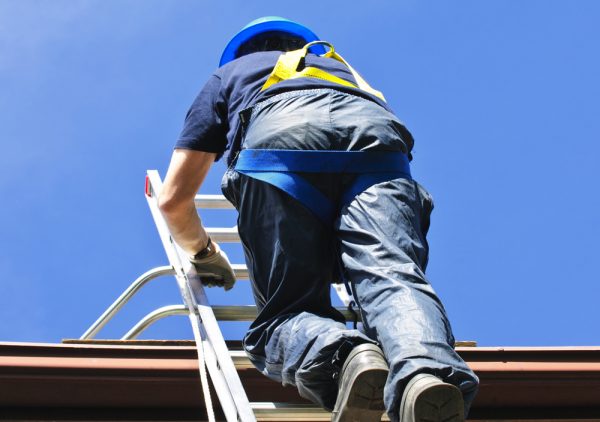Blog

The roof of your home or business wasn’t really designed with foot traffic in mind, which means climbing on it can be dangerous. If you do need to venture up on your roof for cleaning or maintenance, here are some basic safety tips to keep in mind.
Choose the right ladder
If you are going to use a ladder, use a sturdy ladder. Aluminum and fiberglass are popular options, but check the weight rating for any ladder you use. When the ladder is set up against the side of a house, it should extend at least three feet above the edge of the roof.
Do not climb on any rung above the edge of the roof, and keep both hands on the ladder as you make the transition onto the roof. Raise and lower tools after establishing yourself on the roof, not while climbing. These same actions in reverse will also help with making a safe descent.
Secure the ladder properly
A ladder is your link from roof to ground. It should be stable, which means all legs should be sitting flat on the ground to avoid rocking or slipping. A partner on the ground can help with stabilizing the ladder, as can tying off the ladder.
The angle of the ladder is an important part of set up and use. The general recommendation is that the bottom of the ladder should be one foot away from the roof for every four feet of ladder height. For example, a sixteen foot tall ladder should sit four feet away from the edge of a roof.
Avoid steep roofs
Steep roofs should be left to the professionals or those who know how to safely set up a roof harness system. If you are uncomfortable with a more shallow roof, harnesses and roof brackets are available for your use. Always follow instructions on installation and be sure the brackets are nailed into an actual truss or rafter.
Watch for other areas of risk
There are lots of areas of risk on a roof, so be sure to keep an eye out for these dangers anytime you are on a roof. Avoid stepping on any debris or impediments like leaves, branches, or tools. Be aware of any skylights and avoid stepping on them. Also watch out for edges and level splits that can be a tripping hazard. It’s also important to check the weather before getting on the roof to avoid high winds, rain, or lightning. Finally, keep in mind that lifting and working on a roof can lead to strains or other injuries.
For most people, getting on the roof is a rare occurrence, and those who are not properly trained or prepared should avoid it. It is better to seek the help of a qualified and experienced roofer rather than putting oneself at risk.

Let's Talk
Get in touch to get started on your roof today. We are happy to answer any of your questions. Feel free to schedule your free roof inspection as well.
